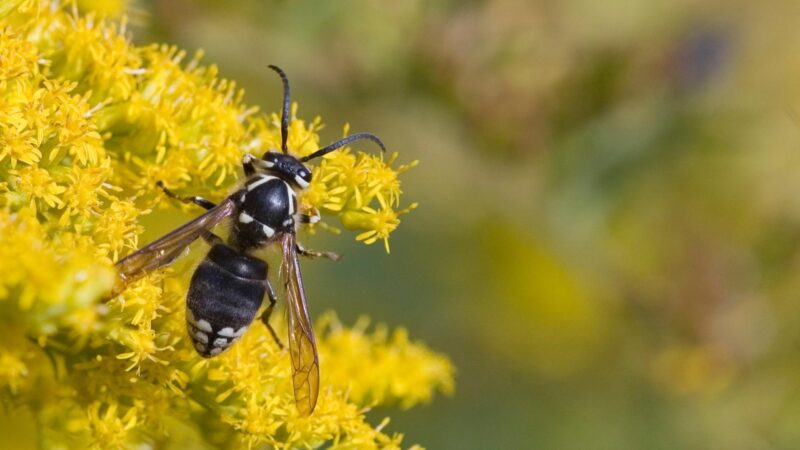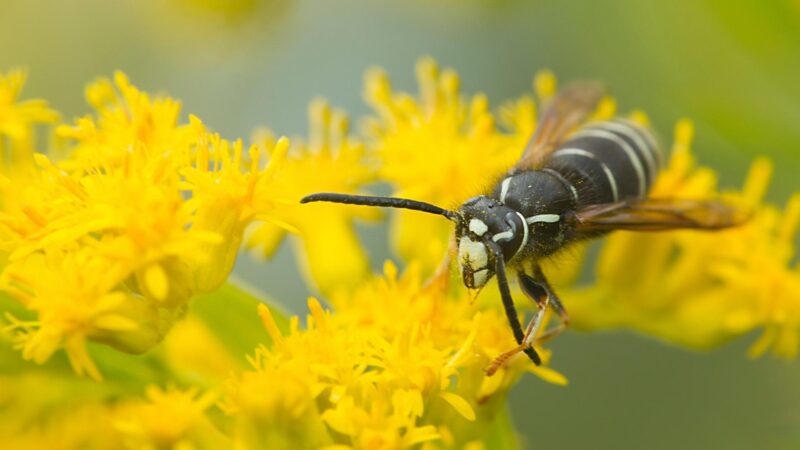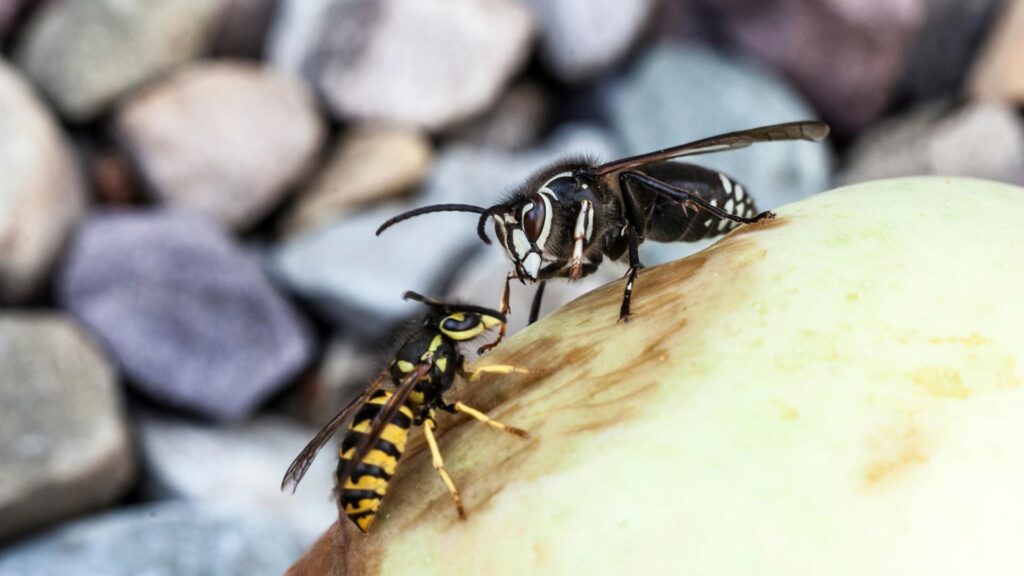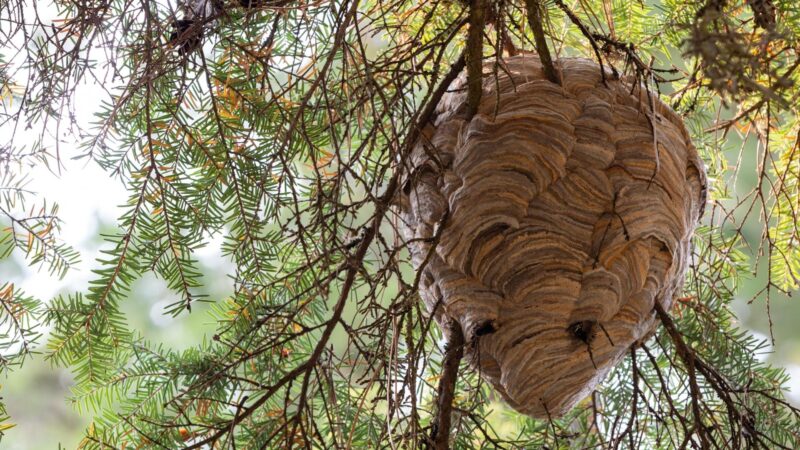The bald-faced hornet is one of the most misunderstood insects in gardens. Judging from their size and appearance, people can easily get intimidated by them.
Many people who have already encountered bald-faced hornets call them either beneficial insects or stinging insects that should be avoided.
What is a bald-faced hornet? Contrary to what some people think, a bald-faced hornet is not a “true” hornet. Instead, it is a yellowjacket species that belongs to the cosmopolitan family, Vespidae. Scientifically known as Dolichovespula maculata, bald-faced hornets are social wasps found throughout North America.
Like all social wasps, bald-faced hornets form a colony and have a queen to protect. But then, they differ in the size of the colony and defensive behavior.
This is why it is very important to know them first before taking any action. This guide has everything you should know about bald-faced hornets and how to deal with them.
Table of Contents
What Does a Bald Head Hornet Look Like?

Bald-faced hornets got their name since their faces have ivory-white marks. They have black and white bodies and white markings on their thorax, abdomen, and legs.
These wasps also have modified ovipositors, brown eyes, and brown wings. Like other hornets, their front wings are folded laterally when they are at rest.
The queen bald-faced hornet is 18-20 mm long and is the largest in their colony. Workers are only about 12-14 mm long.
Male bald-faced hornets have 13-segmented antennae and 7-segmented abdomens. On the other hand, females have 12-segmented antennae and 6-segmented abdomens with white marks.
Where Are Bald-Faced Hornets Found?

Bald-faced hornets are commonly found in their nests, which usually hang in trees, utility poles, or attached to the sides of buildings. They may also nest in attics, hedges, and other elevated areas near homes.
Their football-shaped nests are usually made of chewed weathered wood and may contain 100-400 workers.
How Long Do Bald-Faced Hornets Live?

Bald-faced hornets have an average lifespan of 1 year, which is also the same length of time a colony exists. Males live only between 12-22 days and will die after mating.
Fertilized queens survive winter and will start a new colony in the spring. They will die shortly after laying their second batch of eggs in the fall.
Do Bald-Faced Hornets Eat Mosquitoes?
Bald-faced hornets eat mosquitoes and other pest insects such as aphids, flies, caterpillars, and other yellowjackets. These fierce predators mainly feed on soft-bodied insects and spiders to get protein.
Interestingly, mothers and workers carry their prey to their nests and feed their developing larvae.
Do Bald-Faced Hornets Eat Honey Bees?
Bald-faced hornets eat honey bees. Aside from their sugar content, live bees also provide protein for these yellowjackets. Adult bald-faced hornets may attack a bee hive but will only eat a few of the honey bees.
They prefer eating honey rather than bees. Mothers also bring home honeydew for their young.
Are Bald-Faced Hornets Aggressive?
Bald-faced hornets are aggressive but only to defend their nests. There are guards that will alert the colony once they feel threatened. They will swarm and chase intruders.
But despite being huge and having a ferocious appearance, these wasp species are not as aggressive as the smaller species of yellowjackets.
How Far Will Hornets Chase You?
Hornets may start chasing people who are about 2-3 meters (6.5-9 feet) away from their nests. There is no scientific study stating how far they can chase humans.
However, they are fast fliers and can fly upwards and downwards. Their speed is said to be 6 meters per second and can chase up to 50-100 feet away.
How Bad Is a Bald-Faced Hornet Sting?
Unlike bees, the stingers of bald-faced hornets are smooth and not barbed. This means that they can sting multiple times, and their stings can be very painful.
Once these yellowjackets sting, they inject mild venom but can cause itch and skin swelling for 24 hours. In the worst cases, allergic reactions can lead to death.
Can Bald-Faced Hornets Sting Through Clothes?
Bald-faced hornets can sting through clothes. This is why you should always wear proper PPE (personal protective equipment) when dealing with them.
This includes thick jackets, gloves, a hat, and long pants that are tucked into your socks. For added safety, also wear protective eyewear and a face shield.
Are Bald-Faced Hornets the Same as Paper Wasps?

Bald-faced hornets are not the same as paper wasps (Polistes dominula), but they have a lot of similarities. Both of them are social wasps and use paper-like materials, saliva, and shredded wood for their nests.
Paper wasps also sting to defend their nests, but they tend to be less aggressive than bald-faced hornets.
Should I Remove a Bald-Faced Hornet Nest?

The decision to remove a bald-faced hornet’s nest depends on its location. If the nest is high in a tree or around your house, you can just ignore it. After all, it will be gone in winter or will be attacked by natural predators.
If the nest is on your wall or near your house, remove it, but only after killing all the wasps inside.
Are Bald-Faced Hornets Beneficial?
Bald-faced hornets are considered beneficial insects for two good reasons. As mentioned earlier, they help a lot in controlling garden pest insects such as flies and mosquitoes.
But being omnivores, they also feed on flower nectar and other sugary plants, especially in summer. Therefore, bald-faced hornets are pollinators.
What Keeps Bald-Faced Hornet Away?
Keeping bald-faced hornets away can be dangerous and challenging. Note that there are hundreds of them inside the nest, ready to attack you once you get closer.
But if you are brave enough and you are wearing protective clothing, you may be able to repel them. Here are some common wasp repellents you can try:
- Soap and water
- White vinegar
- Some essential oils
- Bleach
- Aerosol sprays
How to Spray a Wasp Nest Safely and Effectively?
Dealing with a wasp nest is quite dangerous, especially if you are allergic to insect stings. Even if you are not, bald-faced hornet stings are still extremely painful. Some sprays are also toxic.
So, aside from wearing proper PPE, here are some tips on how to spray a wasp nest safely and effectively:
- During the day, assess the location of the nest opening.
- Nest treatment should be done after dark. This is the time when most wasps are resting or sleeping inside the nest.
- If you need a ladder, make sure it is durable. Place it properly so you can climb down safely.
- If you will use a flashlight, don’t point it directly at the nest opening. Otherwise, the wasps will be disturbed and will attack you.
- Spray directly on the nest opening for a few seconds at a distance of 10-15 feet. Make sure the spray penetrates inside the nest. If you are using insecticides, don’t allow them to get into contact with your eyes and skin.
- After spraying, slowly move away from the nest and leave it for about 24 hours.
- In most cases, you may have to spray for several days to eliminate all the wasps.
- Remove or destroy the nest only if all the wasps are dead or gone.
How Do You Get Rid of Bald-Faced Hornets?
Again, you should eliminate bald-faced hornets only if their nest is nearby or there is a chance that they will attack you. If you are allergic to a bee sting or the infestation is severe, don’t do it alone.
Instead, call professional pest control. But if you think it is safe, here are some tips to get rid of bald-faced hornets:
1. Reduce Food Attractants
Minimize food attractants outside your house. Avoid eating sweet foods such as fruits, ice cream, and chocolate. Cover your food and beverages when not eating and drinking.
Clean leftovers and the eating area, and throw away food wrappers at once. Move your trash cans away from the nest and cover them properly.
2. Soap and Water Spray
Using soap and water spray only works well on very young nests of bald-faced hornets and other wasps. This means that they are only a few wasps inside.
To make a soapy water spray, mix 2-3 tablespoons of dishwashing soap with a spray bottle filled with water. Soap kills wasps and yellowjackets almost instantly.
3. Essential Oil Sprays
According to a study, some essential oils can drive social wasps, such as bald-faced hornets away from their nest. This includes citronella, clove, geranium, lavender, lemongrass, and peppermint.
Mixing clove, geranium, and lemongrass as spray appears to be better than using only one kind of essential oil.
4. Residual Insecticides
Residual insecticides such as bifenthrin, chlorpyrifos, cyfluthrin, esfenvalerate, permethrin, and tetramethrin are very effective in eliminating all wasps.
These components remain active for several hours or days, depending on the severity of the problem. Spray them only when children and pets are far away from you.
What Is the Best Spray for Bald-Faced Hornets?
Finding the best spray for bald-faced hornets can be very challenging. Aside from being effective, they should be less toxic to humans and pets.
There are tons of wasp and hornet sprays on the market today, and all of them promise to produce positive results. But so far, here are the three trusted brands you can rely on:
1. Raid Wasp and Hornet Killer
Needless to say, Raid is a very famous brand when it comes to insect sprays. Raid Wasp and Hornet Killer contains 0.05% cypermethrin and offers a direct spray, which kills hornets and wasps on contact. Since spraying once may not solve the problem, this pack has three 17.5-ounce cans for your follow-up spray.
2. Ortho Home Defense Hornet & Wasp Killer
Ortho Home Defense Hornet & Wasp Killer contains cypermethrin. But instead of the usual direct spray, this trusted product is a broad spray that covers a wider area so that wasps that enter and leave the nest will be saturated at the same time. This jet spray can be used effectively up to 20 feet away from the wasp nest.
3. Hot Shot Wasp & Hornet Killer
Hot Shot 13415 HG-13415 Wasp & Hornet Killer is an aerosol spray that kills wasps and hornets on contact but doesn’t leave a stain on home siding. This pyrethroid insecticide has a low toxicity level and can also reach up to 27 feet away. This means that you don’t have to worry about getting near the wasp nest.
Summary
Controlling bald-faced hornets should not be done every time you see them and is not for everyone. Although they sting, these wasps also provide great benefits to the environment by making plants healthier through pollination.
So, if their nests are not bothering you, let them alone. After all, it’s only for a year.
List of Sources
Stinging Insects: Bald-Faced Hornets and Aerial-Nesting Yellow Jackets
Controlling Baldfaced Hornets and Yellowjackets in and Around Structures